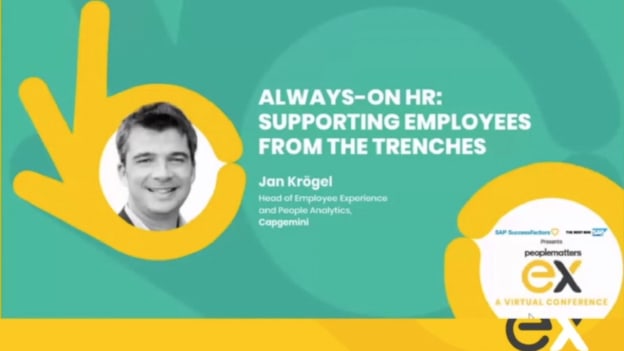Supporting employees from the trenches: Capgemini's EX framework

How can an organization plan and build the right processes to support employees from the trenches and during the worst times? At the People Matters EX Virtual Conference held on June 19, Jan Krögel, Head of Employee Experience and People Analytics at Capgemini, shared the experience of developing and implementing an effective employee experience framework.
Capgemini embarked on its EX development journey three years ago, and the first step, according to Jan, was to define employee experience in a quantifiable, actionable way. The second step was to understand what are the markers of success and how to identify them. This would in turn help to identify the areas for improvement.
The challenge was of course that the experience any one employee has in an organization is not going to be the same as any of his or her colleagues. Furthermore, the elements shaping that experience are many and varied.
Address variation by creating a single, globally aligned framework
"The key driver for aligning such a big group is to create an inspiring framework that pulls people together while allowing them enough autonomy to meet their needs," said Jan. Accordingly, he and his team designed a single employee experience framework that could be used across the globe. The framework has three pillars:
Firstly, the idea of connected management practices.
"The front line manager is really the key driver of employee experience," Jan shared. |No surprise there, but when we actually quantified the touchpoints that an employee lives through, we found that 50-60 percent of those touchpoints were owned by the manager."
"Whatever we design as a corporation in terms of process and experience, it only comes to life if the manager who owns and acts on those 50-60 percent of touchpoints is actually doing it the right way."
Hence, he said, the focus should be on empowering managers.
The second pillar is the use of six cross-functional levers to address the typical experience areas that an employee might face. Capgemini's framework organizes these areas based on the employee's viewpoint. These six levers are each driven by different functions, but they have to be viewed from a cross-functional perspective, so that each aspect of employee experience is simultaneously covered from multiple directions.
"We need to work together at the business level to create a strong experience that is not siloed to one or two functions," Jan shared.
The third pillar is the use of people analytics for a more data-driven approach. Jan and his team use two different measurement mechanisms for this. The first, used for continuous employee listening internally, is called Pulse and uses regular surveys to collect quantifiable data for people analytics, The second, used for brand and people perception, is Glassdoor, which provides a source of data to help them understand how employees perceive the company. This shift, he said, required the most change and thinking.
Driving improvements through measurements
Jan's team concluded that employee experience only impacts business performance if it generates people engagement. The question for any given perk or initiative, therefore, is what its actual impact on engagement is.
The use of data allows organizational alignment around EX from the top leadership all the way down to operational management. It creates a common language around engagement, and provides a basis for the development and implementation of new EX initiatives. For example, any given initiative can be attached to any of the levers identified under the framework, for full clarity on how it fits into the overall experience strategy, what experience needs to be improved, and how that should be done.
"When what we do in employee experience changes, we need results and improvement in engagement," Jan said, pointing out that measurements are key to improvements. "This is achieved by providing managers with timely local insights into what they can do."
Each month, he shared, the EX team collects data from all employees around 14 chosen drivers of engagement identified under the framework, drawing from a pool of survey questions designed to cover all the drivers without repeating more than twice. The collected data is then run through a powerful analytics tool that allows managers to view the data real-time. The managers can independently access the data and act on it, which allows quicker closing of the feedback loop at the front-line level.
The top challenge Jan and his team encountered when implementing this capability was getting people aligned and then sustaining it. Such a continuous approach, he said, requires a deep mindset change among users and advocates alike. It also requires HR to be fully upskilled and capable of making full use of the model in order to conduct the most effective discussions with the business leadership.
On the other hand, the top benefit of the EX framework is that it gives them a way to name and identify aspects of EX, to measure these areas and create discussions around them, and then to manage these aspects to generate tangible benefits across the entire Capgemini Group. The data-driven approach has given structure to the entire "soft" discussion of employee experience, and allowed the linking of organizational values to the perception and thinking around talent brand drivers.
"It has been a catalyst for Group transformation," he said. "Without that measurement, we would never have been able to come as far as we have."
















